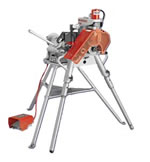

Roll Grooving
Roll grooving moves a small portion of the pipe wall orbitally by a cold-forming process. The end of the pipe is placed between the roll set of a grooving machine. As the roll set closes, the pipe compresses as it rotates. This leaves a smooth recessed groove around the outside diameter and an indent on the inside diameter of the pipe being grooved. Roll grooving can be applied on heavy and light-walled pipes without weakening them against corrosion. However, if the pipe wall is too thick, cut grooving the pipe will provide a more reliable groove.
Cut Grooving
While roll grooving is very popular, cut grooving is still useful in many applications. For instance, if the pipe wall is too thick, cut grooving the pipe will provide a more reliable groove. Alternatively, if a pipe is internally lined or coated, cut grooving can preserve the lining and coating. In fact, even the pipe material can dictate the groove style; some pipe material must be cut grooved.
At DS Pipe & Steel, we offer both roll and cut grooving services. We provide roll grooving up to 24″ Std wall carbon steel pipe and cut grooving up to 8″ Std wall carbon steel pipe. We also roll groove copper tubing from 2″ to 8″ and 10S Stainless Steel pipe up to 24″ in diameter.



